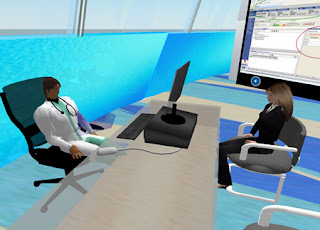
The Virtual World is attracting heath researches.
Health care researchers also are starting to use Virtual Worlds for research, education and data collection.
Two recent initiatives cover chronic illnesses schizophrenia and obesity.
Peter Yellowlees, a psychiatrist at the University of California-Davis Medical Center, created a "virtual psychosis" environment on the Second Life Web site to help students and health care professionals understand the types of hallucinations that people with schizophrenia and other mental disorders have.
The University of Houston's Texas The Virtual World is attracting heath researches.
Health care researchers also are starting to use Virtual Worlds for research, education and data collection.
Two recent initiatives cover chronic illnesses schizophrenia and obesity.
Peter Yellowlees, a psychiatrist at the University of California-Davis Medical Center, created a "virtual psychosis" environment on the Second Life Web site to help students and health care professionals understand the types of hallucinations that people with schizophrenia and other mental disorders have.
The University of Houston's Texas Virtual World is attracting heath researches.
Health care researchers also are starting to use Virtual Worlds for research, education and data collection.
Two recent initiatives cover chronic illnesses schizophrenia and obesity.
Peter Yellowlees, a psychiatrist at the University of California-Davis Medical Center, created a "virtual psychosis" environment on the Second Life Web site to help students and health care professionals understand the types of hallucinations that people with schizophrenia and other mental disorders have.
The University of Houston's Texas CThe Virtual World is attracting heath researches.
Health care researchers also are starting to use Virtual Worlds for research, education and data collection.
Two recent initiatives cover chronic illnesses schizophrenia and obesity.
Peter Yellowlees, a psychiatrist at the University of California-Davis Medical Center, created a "virtual psychosis" environment on the Second Life Web site to help students and health care professionals understand the types of hallucinations that people with schizophrenia and other mental disorders have.
The University of Houston's Texas Obesity Research Center plans to recruit 500 participants from different countries for an obesity study that will reward users' online characters, or avatars, for healthy dietary habits and increased physical activity. Participants will be monitored online and will report their weight and activity to help researchers determine if participating in the virtual world encourages individuals to lose weight and practice healthy behaviours themselves.
"What we're seeing in Second Life is the beginning of serious interest on the part of health care professionals," stated John Lester, Boston operations director for Linden Lab.
Research is just one area of health attracted to Virtual Worlds (please refer to AI 33 and AI 34).
Research Center plans to recruit 500 participants from different countries for an obesity study that will reward users' online characters, or avatars, for healthy dietary habits and increased physical activity. Participants will be monitored online and will report their weight and activity to help researchers determine if participating in the virtual world encourages individuals to lose weight and practice healthy behaviours themselves.
"What we're seeing in Second Life is the beginning of serious interest on the part of health care professionals," stated John Lester, Boston operations director for Linden Lab.
Research is just one area of health attracted to Virtual Worlds (please refer to AI 33 and AI 34).
Research Center plans to recruit 500 participants from different countries for an obesity study that will reward users' online characters, or avatars, for healthy dietary habits and increased physical activity. Participants will be monitored online and will report their weight and activity to help researchers determine if participating in the virtual world encourages individuals to lose weight and practice healthy behaviours themselves.
"What we're seeing in Second Life is the beginning of serious interest on the part of health care professionals," stated John Lester, Boston operations director for Linden Lab.
Research is just one area of health attracted to Virtual Worlds (please refer to AI 33 and AI 34).
Research Center plans to recruit 500 participants from different countries for an obesity study that will reward users' online characters, or avatars, for healthy dietary habits and increased physical activity. Participants will be monitored online and will report their weight and activity to help researchers determine if participating in the virtual world encourages individuals to lose weight and practice healthy behaviours themselves.
"What we're seeing in Second Life is the beginning of serious interest on the part of health care professionals," stated John Lester, Boston operations director for Linden Lab.
Research is just one area of health attracted to Virtual Worlds (please refer to AI 33 and AI 34).





























